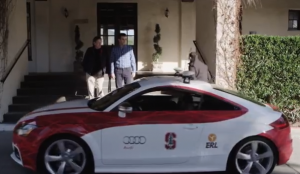With current concerns over the dangers of texting and driving, car manufacturers globally are researching and introducing new in-car technologies, some of which might be adding to the problem, while others may be making the problem entirely irrelevant.
General Motor’s chief executive, Dan Akerson, revealed in a recent talk that the company is planning on making future GM car’s mobile communications platforms to attract younger, more tech focused buyers.
Next year the car-maker will start selling cars equipped with 4G LTE mobile broadband, which will allow occupants (we hope not the driver) to watch streaming video in the vehicle.
Akerson’s enthusiasm for combining car and telecommunications technology is no surprise given he was a former top exec with telecom companies MCI and Nextel prior to joining GM.
However, a traffic safety organisation in the US wants car manufacturers to disable in-car social media and email interaction functions, claiming studies show these are very distracting to drivers – more so than simply talking to a fellow passenger or even talking on a phone.
The difficulty is that interacting with email and social media is a ‘significant cognitive distraction’, since the brainpower required to complete these tasks impairs the driver’s reaction times and ability to process what’s going on around them at a level equivalent to a 0.08 blood alcohol level, higher than the Australian legal limit of 0.05 (and equal to the 0.08 limit in the UK and US).
Car manufacturers are nonetheless pushing ahead with voice recognition systems, with over half of all cars predicted to integrate these systems by 2019. Some high end vehicles already integrate these functions, such as the BMW 7 series where the driver can dictate text messages and emails.
Mind you, these concerns will disappear altogether if full car automation becomes a reality, and it may be closer than you think. The World Health Organisation for one would welcome self driving cars.
They estimate that 1.24m people die every year as a direct result of motor vehicle accidents, and the most common cause is human error. Unfortunately half of these fatalities are not car drivers, but pedestrians, cyclists and motorcyclists.
Google’s self driving cars (which we covered here), a specially equipped Lexus, and a small fleet of converted Toyota Priuses, have already driven over half a million miles without humans at the wheel, but it turns out they’re not the only ones developing self driving cars.
Both Mercedes and Audi are working on self driving models (and if you haven’t seen this Audi TV ad with the new and the old Mr Spock, you should watch it – but make sure you watch it right to the end), with Mercedes saying they could have incorporated self driving into the new S-Class, they just weren’t totally confident it would pick up absolutely everything, yet.
But if technology is already this advanced in testing, we could be only a year away from the first driverless cars coming on to the market.
So when that first model comes out and you prefer to be driven rather than drive yourself (and you can’t afford a chauffeur), put your name down for a deposit and give us a call to arrange your car finance.
Mind you we’ve got a funny feeling it’ll probably be cheaper to get a normal car and a chauffeur for a year, for the price we expect you’ll pay for the first driverless car in the showrooms!
Car fact: the new Mercedes S-Class has 30 million lines of code in its on board computers. The F35 Joint Strike Fighter has only 5.7 million.




